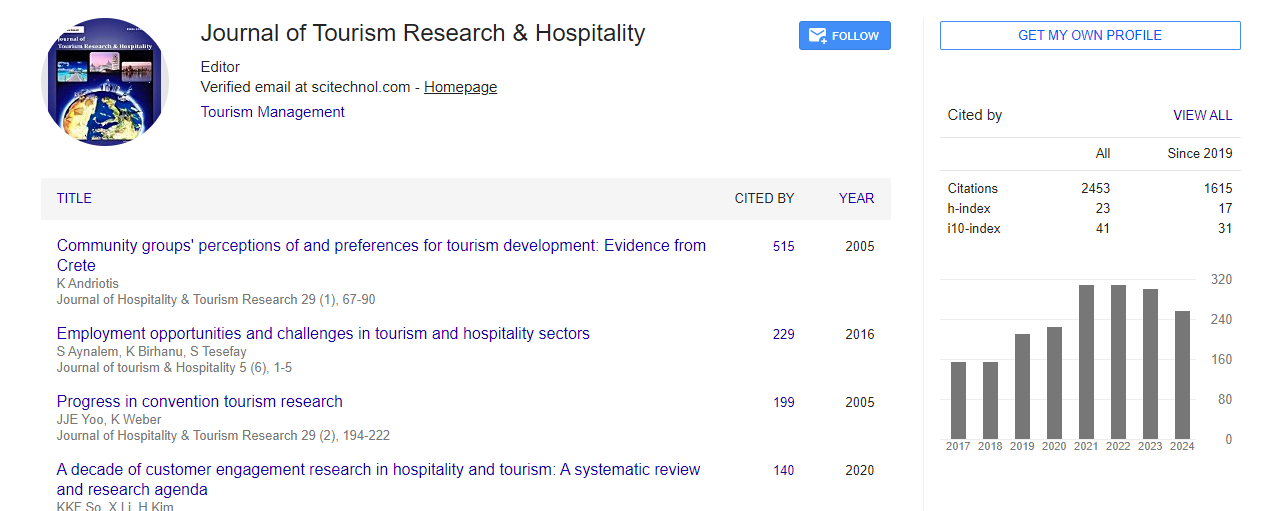Commentary, J Tourism Res Vol: 12 Issue: 5
Exploring the Process and Techniques of Tourism Marketing
Yarienl Faing*
1Department of Tourism, Huaqiao University, Fujian, China
*Corresponding Author: Yarienl Faing,
Department of Tourism, Huaqiao
University, Fujian, China
E-mail: yarienl_faing@hu31.cn
Received date: 20 September, 2023, Manuscript No. JTRH-23-122072;
Editor assigned date: 22 September, 2023, PreQC No. JTRH-23-122072 (PQ);
Reviewed date: 05 October, 2023, QC No. JTRH-23-122072;
Revised date: 12 October, 2023, Manuscript No. JTRH-23-122072 (R);
Published date: 19 October, 2023, DOI: 10.4172/2324-9110.10001046
Citation: Faing Y (2023) Exploring the Process and Techniques of Tourism Marketing. J Tourism Res Hospitality 12:5.
Description
Tourism marketing is a dynamic and multifaceted field that goes beyond the mere promotion of destinationsit's about interesting narratives, tapping into traveller aspirations, and leveraging diverse strategies to attract and engage a global audience. The complex process and techniques of tourism marketing, examining how destinations harness creativity, technology, and consumer psychology to leave a lasting impression on prospective travellers. At its core, tourism marketing involves a strategic and systematic approach to promoting destinations, experiences, and services to a targeted audience. The process typically begins with thorough market analysis to identify the target demographic, understand their preferences, and assess market trends. Armed with this information, destination marketers can tailor their strategies to resonate with the desires and expectations of potential travellers.
In the digital age, online platforms serve as powerful tools for tourism marketing. Techniques such as Search Engine Optimization (SEO), content marketing, and social media engagement play pivotal roles in reaching a global audience. Social media platforms, in particular, provide a direct and interactive channel for destinations to showcase their uniqueness. Captivating visuals, user-generated content, and real-time engagement develop a sense of community and encourage travellers to share their experiences, thereby amplifying the destination's digital presence.
The process of tourism marketing has evolved to embrace personalization as a key technique. Tailoring marketing efforts to individual preferences and behaviors enhances the relevance of promotional content. From personalized email campaigns to targeted advertisements based on user behavior, the goal is to make potential travellers be noticed and understood. This not only increases the effectiveness of marketing efforts but also promotes a connection between the destination and the audience.
As competition in the tourism industry intensifies, destinations are exploring innovative techniques to stand out. Virtual Reality (VR) and Augmented Reality (AR) experiences allow potential travellers to virtually explore destinations, providing a preview of what awaits them. Interactive online platforms and gamification techniques further engage audiences, turning the travel planning process into an enjoyable and memorable experience.
Collaboration is a powerful technique in tourism marketing. Destinations often partner with airlines, hotels, influencers, and travel agencies to amplify their reach. Cross-promotional campaigns leverage the strengths of each partner, developing a mutually beneficial ecosystem. Influencer marketing, in particular, has gained prominence, with influencers sharing their travel experiences and recommendations to a wide audience.
An integral part of the tourism marketing process involves continuous evaluation and adaptation. Analysing the effectiveness of campaigns through metrics such as website traffic, social media engagement, and conversion rates allows marketers to refine their strategies. This continuous approach ensures that marketing efforts stay aligned with evolving consumer trends and preferences.
Conclusion
The process and techniques of tourism marketing are a dynamic blend of creativity, technology, and strategic thinking. As destinations seek to capture the attention of a diverse and discerning audience, they must navigate the ever-changing landscape of digital marketing, embrace innovative narrating, and build meaningful connections with potential travellers. By understanding the complexities of the tourism marketing process and employing a mix of techniques, destinations can not only attract visitors but also develop lasting impressions that resonate long after the journey has ended. In a world where travel is as much about experiences as it is about destinations, effective tourism marketing becomes the gateway to turning dreams of exploration into vibrant and unforgettable realities.
 Spanish
Spanish  Chinese
Chinese  Russian
Russian  German
German  French
French  Japanese
Japanese  Portuguese
Portuguese  Hindi
Hindi 

